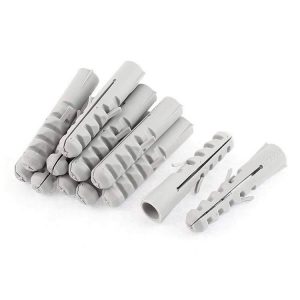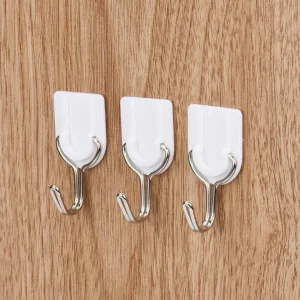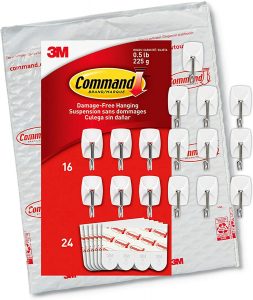Screw hooks are one of the most useful tools in your home. They’re great for hanging decorations, towels, coats and other things that need to be hung up. However, they can be difficult to put up without the right tools and a bit of know-how.
Several Ways to Install Screw Hooks without a Drill
Use a Hammer and Nail Set

This method works well if there is a stud or something similar behind where you’re hanging your screw hook. You can simply hammer the nail into place and then drive in your screw hook with just a little bit of elbow grease!
Use an Anchor

Another option for installing screws without a drill is using an anchor kit instead of drilling holes into your walls or floorboards. This is another easy option that doesn’t require any tools at all! Simply use one of the screws included in your anchor kit as an anchor point for your screw hook and then drive it in until it’s secure!
Stick-on Hooks

If you’re looking for a way to hang things without using a drill or screws, stick-on hooks are a great alternative. They’re also perfect for renters who don’t want to make holes in their walls.
Stick-on hooks come with adhesive backing, so all you need to do is peel off the backing and stick them onto any smooth surface — like tile, wood or glass — and they’ll stay put.
For a more permanent option, look for stick-on hooks that have adhesive backing on both sides of the hook. This allows you to stick the hook to a piece of plywood or even another wall if you need to reposition it later.
Double-Sided Hooks

The hook has a tendency to pull out of the wall before the screw is completely in place.
Use this type of hook when you want something that will hold up heavy items such as coats and jackets, or even bicycles.
Screw Eyes

You can buy screw eyes with set screws or without them. If you have an older home with plaster walls, then you’ll need to buy the ones without set screws because they won’t hold in plaster.
To install a screw eye, first determine where on the wall you wish to place it. For example, if you want to hang something from a window frame, then measure from the top of the frame down to where you’d like your hook to go and mark this measurement on the wall with a pencil.
Next, take your screw eye and place it over your mark so that it covers both marks and lightly tap it into place with a hammer until it’s level with the surface of the wall and flush against all four sides of your markings (make sure not to hit any pipes or wires).
Screw Eyes with Jaws

The screw eye has a threaded shaft which screws into the wood. The threads on this shaft can be either coarse or fine, depending on the thickness of your material.
The nut has a bit that grabs onto the end of the shaft and secures it in place. It may have a flange around its edge that goes into the hole first, helping to secure it against turning while you tighten down on it.
Nail Plugs

To use nail plugs, simply insert them into the hole until they’re flush with the wall. Then, hammer their heads down until they’re flush with the surface of the wall.
One advantage of using nail plugs is that they don’t leave any trace behind when you remove them. If you want to remove a nail plug, simply pull it out with your fingers or use a pair of pliers to gently pry it out from below.
Double-Sided Tape (Sticky Hooks)
 The adhesive on these types of hooks is strong enough to hold up heavy items without the need for screws or nails. To use them, simply peel off the backing paper and stick them onto the wall where you want to hang something.
The adhesive on these types of hooks is strong enough to hold up heavy items without the need for screws or nails. To use them, simply peel off the backing paper and stick them onto the wall where you want to hang something.
Then simply put whatever you want on top of it and pull off the tape cover from underneath so that it’s sticking directly onto the wall itself.
These types of hooks are ideal if you have children in your home because they don’t pose any safety risks if they pry off their weight from them while playing around the house.
However, there are many other types of sticky hooks available which may be better suited depending on what type of object you want to hang up in your premise.
Magnets (Magnetic Hooks)
 These are a great option for hanging bags and other items that you may need to access quickly. They’re also perfect for situations where you might not want to drill into your wall. The best part about magnetic hooks is that they can be installed without any tools at all.
These are a great option for hanging bags and other items that you may need to access quickly. They’re also perfect for situations where you might not want to drill into your wall. The best part about magnetic hooks is that they can be installed without any tools at all.
Simply peel off the backing and stick them to your wall or door, then hang your item on it.
You can also get magnetic strips that can be used as shelf brackets or on a flat surface. These strips come in different sizes and shapes, so you’ll want to make sure you get the right ones for your needs.
Command Strips

The first thing you should do when installing Command Strips is make sure there are no sharp edges or exposed screws that could get caught in the hooks.
Once they’re up, you can remove the backings and stick the strips onto whatever surface you want. Just make sure you press down hard enough to get a good seal between the two pieces of plastic so nothing falls off when you move it around.
Use a Hammer and Screw Hook to Pound the Screw Hook into the Wall

This method is also useful for hanging pictures, mirrors and other items that weigh less than 20 pounds.
The first thing you want to do is measure where you want the screw hook installed and mark that spot with a pencil or marker.
After that, you need to push the screw hook through from behind until you can feel it against your fingers. Position it so that it’s almost flush with the wall surface. Pull out any excess material from behind the wall with your hand until you’re satisfied with its position.
Finally, you want to apply wood glue to the back side of each screw hole on your picture frame or whatever item you’re hanging on your wall. You’ll need at least two drops per hole, so double-check before proceeding.
Final Thoughts
Screw hooks are great for hanging things, but they can be tricky to install. The problem is that you usually need a drill to get the screw hole started. However, there are several ways to do it without a drill and this article highlights them.

